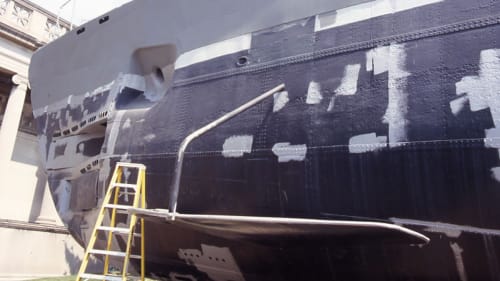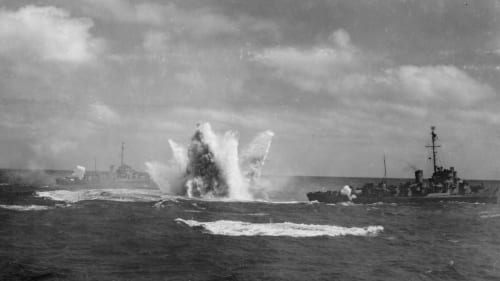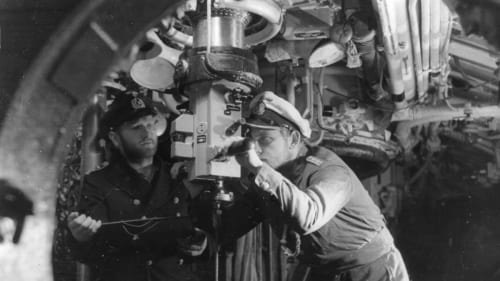The First Exhibition of U-505
A secret made public
By the close of 1944, the Allies had a strong upper hand in the U-boat war. Still, it was not until May 4, 1945 that German Naval Command issued the following order: "Attention all U-boats. Cease-fire at once. Stop all hostile action against Allied shipping." Three days later, Germany officially surrendered to the Allies. With the U-boat threat eliminated, the U.S. Navy no longer needed to keep the U-505 a secret. A press release was issued on May 16, 1945, detailing the capture and salvage effort. In the months that followed, the U-505 went on tour as part of the U.S. government's Seventh War Loan drive to raise funds for the war against Japan. The sub stopped at several East Coast cities, where spectators could climb aboard in exchange for purchasing war bonds.
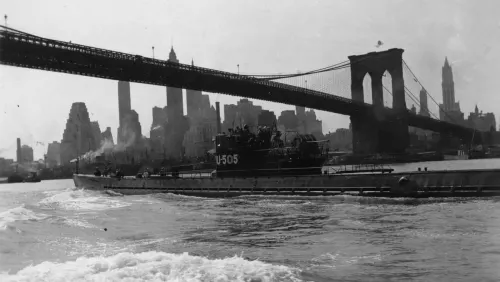
Chicagoans save the U-505
By 1946, the Navy had extracted all the information and technology it needed from the U-505. With no reason to keep the sub, the Navy planned to use her for target practice. The story of the U-505 would have ended there were it not for Retired Admiral Daniel V. Gallery, Griffin Museum of Science and Industry and the people of Chicago. A Chicago native, Gallery was looking for a permanent home for the U-505 in his hometown. As luck would have it, the Museum had long been searching for a submarine for its collection. In 1953, Gallery and Museum President Lenox Lohr convinced Under Secretary of the Navy Charles S. Thomas to give the sub to the Museum. The only catch was that the Navy refused to cover the cost of the move. In response, the Museum, the City of Chicago and private groups banded together to raise the $250,000 that would be necessary to repair, move and install the sub for exhibition.
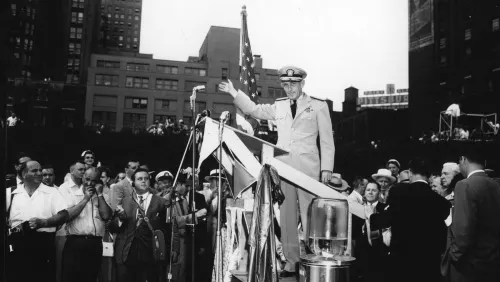
The trip to Chicago
Like the capture and salvage efforts, bringing the U-505 to Chicago proved a monumental undertaking. On May 15, 1954, a tugboat began towing the sub from Portsmouth, New Hampshire, where she was being stored. The tow covered 3,000 miles — through 28 locks on the St. Lawrence Seaway, and through four of the five Great Lakes. The U-505 arrived in Chicago on June 26, 1954, only to face another major hurdle: an 800-foot overland trip from Lake Michigan to the Museum. The task required extensive planning to cross Lake Shore Drive (now DuSable Lake Shore Drive) without destroying the pavement and tying up traffic. Engineers designed an elaborate rail and roller system to move the heavy sub out of the water and over the land. The city closed Lake Shore Drive the night of September 2, 1954 to allow the sub to cross. It took another week for the sub to complete its journey from the road to the Museum. On September 25, 1954, the U-505 was dedicated as a war memorial and a permanent exhibit at Griffin Museum of Science and Industry. In 1989, the sub was also designated as a National Historic Landmark. The U-505 is the only Type IX-C U-boat in existence today.
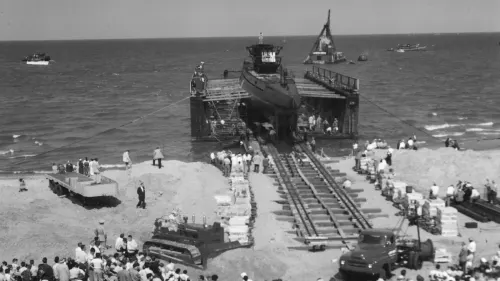
This riveting wartime story comes alive
Experience the only German sub in the U.S. in this dramatic exhibit and national war memorial to American sailors.
